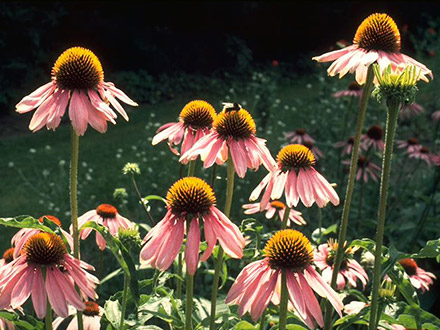Botanical name
Echinacea purpurea (L.) Moench
Echinacea pallida (Nutt.) Nutt.
Echinacea angustifolia DC.
Family
Asteraceae
Common name
Echinacea, Purple coneflower, Coneflower, American coneflower, Hedgehog coneflower
Information about the plant
The genus Echinacea is widely spread in North America and ranges from the Gulf Coastal Plain in the south, across the Great Plains and Central Lowlands, to the Great Lakes in the north. In the east, it includes the Appalachian mountain ranges and reaches its western limit in the area of the Rocky Mountains. The three species E. purpurea, E. pallida, and E. angustifolia overlap in this region. In Europe, the coneflower has now been introduced as an ornamental plant.
The genus name comes from Greek "echinos" (= hedgehog), which explains the name. In fact, the strongly curved conical receptacle resembles a hedgehog with its long tubular flowers, which is also dominated by prickly chaff leaves.
The purple echinacea is the largest of the three species. It grows up to 60 to 180 cm in height, while the pale coneflower only reaches 40-120 cm. Both species have large, oblong-lanceolate, rough, hairy leaves; in the purple-colored echinaceas, these are roughly serrated. Very characteristic are the large flower heads with their strikingly long, drooping, or reflexed ray florets. In the purple-colored echinacea, they are 2 to 4 cm long and purple, while in the pale coneflower they are 4-9 cm long, pink or white (Latin "pallida" = pale). All three species have numerous tubular flowers on the strongly curved flower base. The flowering time is in late summer.
Medicinally used parts of plants (herbal drug)
Both the above-ground parts of the purple coneflower harvested at the time of flowering (purple coneflower herb - Echinaceae purpureae herba), preferably the juice of the fresh herb, and the dried underground parts (purple coneflower root - Echinaceae purpureae radix) are used. The drugs are sourced from crops in America and Europe.
Only the dried underground parts of pale coneflower and narrow-leaved coneflower are used medicinally (pale coneflower root - Echinaceae pallidae radix; narrow-leaved coneflower root - Echinaceae angustifoliae radix). The commercially available drugs come mainly from wild collections in North America and, to a lesser extent, from cultivations in the USA and Europe.
Constituents of the herbal drug
Purple coneflower (herb and root): Polysaccharides, caffeic acid derivatives, alkamides, polyacetylenes, essential oil.
Pale coneflower (root): Polysaccharides, caffeic acid derivatives, ketoalkenes and ketoalkynes, essential oil.
Narrow-leaved coneflower (root): Alkamides, polysaccharides, caffeic acid derivatives, essential oil.
Quality of the drug
The quality of the following drugs or drug preparations is specified in the European Pharmacopoeia (Ph. Eur.):
- Purple coneflower herb (Echinaceae purpureae herba)
- Purple coneflower root (Echinaceae purpureae radix)
- Pale coneflower root (Echinaceae pallidae radix)
- Narrow-leaved coneflower root (Echinaceae angustifoliae radix)
Medical applications
Recognised medical use
Purple coneflower herb
The HMPC concluded that purple coneflower herb medicines taken orally can be used short-term for the prevention and treatment of common colds. For external use, purple coneflower has been classified as a traditional herbal medicinal product (see "Traditional use").
ESCOP: internally for the supportive treatment of recurrent infections of the upper respiratory tract (common cold) and the urinary tract; externally for superficial wounds.
Purple coneflower root
The HMPC has classified purple coneflower root as a traditional herbal medicinal product (see "Traditional use").
ESCOP: for the supportive treatment and prevention of recurrent upper respiratory tract infections (common cold).
Pale coneflower root
The HMPC has classified pale coneflower root as a traditional herbal medicinal product (see "Traditional use").
ESCOP: for supportive therapy and prevention of recurrent upper respiratory tract infections (common cold).
Traditional use
The fresh plant preparations of purple coneflower have been classified by the HMPC for external use as a traditional herbal medicinal product (Article 16a of Directive 2001/83/EC). Based on long-standing use, purple coneflower herb can be used to treat small, superficial wounds (see also "Recognized medical use").
Purple coneflower root, pale coneflower root, and narrow-leaved coneflower root have been classified by the HMPC for internal use as traditional herbal medicinal products (Article 16a of Directive 2001/83/EC). Based on long-standing use, preparations of the three drugs can be used internally to relieve cold symptoms. Purple coneflower root can also be used externally to treat pustules and spots caused by mild acne.
Herbal drug preparations in finished dosage forms
Purple coneflower herb
- Fresh plant press juice in drops and other liquid preparations and ointments
- Echinacea purpurea homeopathic mother tincture in drops
- Dried fresh plant pressed juice in tablets and coated tablets
- Dry extracts in tablets and coated tablets
- Dry extracts in tablets and coated tablets
- Echinacea homeopathic mother tincture in tablets and drop
- Echinacea homeopathic mother tincture in tablets, juice, and drops
Dosage
To ensure the effect, echinacea should only be taken in the form of finished drugs, the dosage is specified in the patient information leaflet.
Preparation of a tea
The preparation of a tea infusion is not recommended.
Notes
Echinacea preparations are to be avoided in people who have an existing allergy to Compositae (Asteraceae) plants. The use of echinacea is generally discouraged for those prone to allergies. Because of the immunostimulatory effects of echinacea, patients with a severe systemic disease, autoimmune diseases, immunodeficiency diseases and those who are immunosuppressed must not use coneflower or echinacea (not for tuberculosis, leukemia, collagenosis, multiple sclerosis, AIDS, HIV infection).
There are still no studies on the safety of the use of coneflower or echinacea during pregnancy and lactation, nor for use in children under 12 years of age. Women who are nursing should not use any ointment containing echinacea for breast care.
Side effects
Allergic reactions
Interactions
None known
References
Herbal drug monographs
HMPC (2012, 2015, 2017, 2018, 2019), ESCOP (2018, 2019, 2021),), WHO Vol. 1
Further literature
Commentary on the European Pharmacopoeia (Purple coneflower herb, No. 1823; Purple coneflower root, No. 1824; Pale coneflower root, No. 1822; Narrow-leaved coneflower root, No. 1821)


